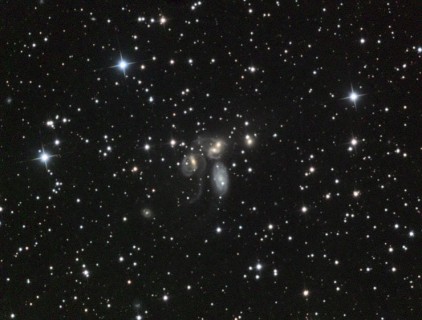7/29/2011 Stephan’s Quintet from Table Mountain
With the addition of our new CCD imaging camera, I have been quite curious to find out how far I can push our imaging setup in terms of being able to record those really dim “faint fuzzies” out there.
The image below is that of Stephan’s Quintet. It was taken from the (mostly) dark sky of the Table Mountain Star party near Ellensburg, Washington. The wikipedia entry on Stephan’s Quintet reads:
“Stephan’s Quintet in the constellation Pegasus is a visual grouping of five galaxies of which four form the first compact galaxy group ever discovered. The group was discovered by Édouard Stephan in 1877 at Marseilles Observatory. The group is the most studied of all the compact galaxy groups. The brightest member of the visual grouping is NGC 7320 that is shown to have extensive H II regions, identified as red blobs, where active star formation is occurring.”
There was quite a wind during the evening I took this image and I had a telescope balace issue as well (who would have guessed my finderscope was throwing the balance off so much!) so these images are not as sharp as I would have liked.
That said, this is a new “personal best” for me. The brightest of the galaxies in this image (NGC7318b – the bottommost of the pair of little spiral guys in the center) is magnitude 13.9.
Stephan’s Quintet
6 exposures of Luminance, with 20 minute subs each
2 exposures of Red, with 20 minute subs each
2 exposures of Green, with 20 minute subs each
2 exposures of Blue, with 20 minute subs each
Imaging scope: Astro-Tech AT10RC Ritchey Chrétien f/8 at 2000mm
Imaging camera: QSI 583wsg monochrome
Guide camera: Starlight Xpress Lodestar
Capture and processing in Maxim DL
Final processing in Photoshop
Enjoy!
